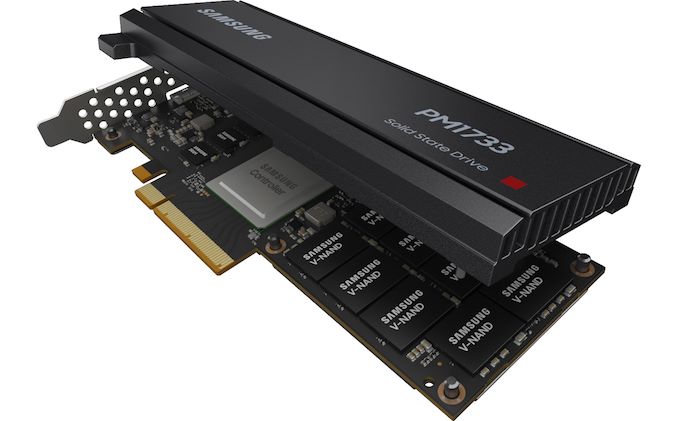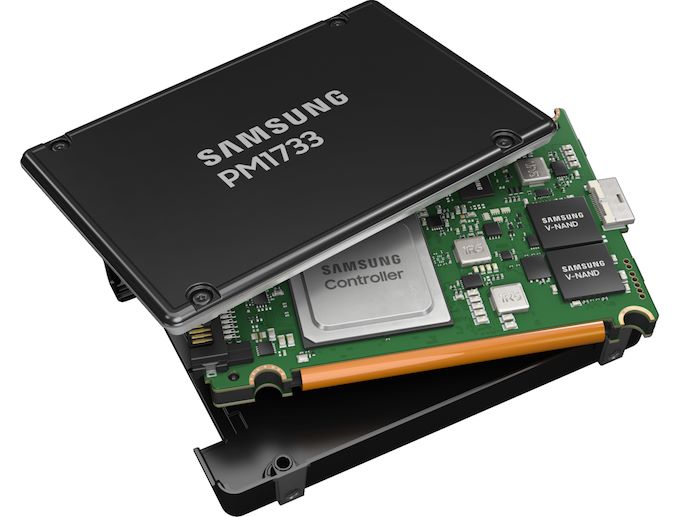Samsung Preps PM1733 PCIe 4.0 Enterprise SSDs For AMD's "Rome" EPYC Processors
by Anton Shilov on August 9, 2019 10:00 AM EST
With the launch of AMD's new second generation "Rome" EPYC processors, AMD's numerous hardware partners have been lining up to announce their own wares built around the new processors. And this doesn't just go for OEMs and integrators, but it also extends to component suppliers who have been eagerly awaiting the first x86 server processor with PCIe 4.0 support. To that end, yesterday Samsung sent out an announcement confirming that their previously announced PM1733 enterprise SSD supports AMD's new processors, and that just in time for inclusion in Rome systems, they'll be shipping this quarter.
Samsung first announced the PM1733 last fall, as part of its general SSD roadmap update for the then-forthcoming year. The PM1733 is the successor to their PM1723b enterprise SSD, and is designed to take advantage of the bandwidth advances provided by PCIe 4.0. Based on the company’s proprietary controller and paired with 512 Gb 5th Generation V-NAND memory chips, the drive family is rated for read speeds of up to 8 GB/second.
Interestingly, Samsung is offering both PCIe 4.0 x4 and x8 versions of the SSDs, with the U.2 versions using a x4 interface while the alf-length half-height (HHHL) card versions will use x8. The U.2 drives with dual-port capability will offer capacities of up to 30.72 TB, whereas the HHHL cards will carry up to 15.36 TB of useful V-NAND flash.
Overall, Samsung's focus on the drive in terms of specifications is on the drive's read performance rather than its write performance. Along with its 8 GB/sec rated sequential read speed, Samsung says the PM1733 can handle random reads of up to 1500K IOPS, which would make the PM1733 among the fastest drives announced so far.
Samsung will start shipments of its PM1733 SSDs this quarter. Among x86 platforms, the PCIe 4.0 capabilities of the drives will only be available on AMD EPYC 7002 and AMD Ryzen 3000 platforms, but the devices will also work with current PCIe 3.0 platforms from Intel and AMD. The manufacturer has not disclosed prices of the new PM1733 SSDs so far.
Related Reading:
- Samsung 30.72 TB SSDs: Mass Production of PM1643 Begins
- Samsung Launches Broad Range Of Datacenter SSDs
- Samsung Launches Energy-Efficient PM883 SSD with SATA 3.3, LPDDR4
- Samsung At Flash Memory Summit: 96-Layer V-NAND, MLC Z-NAND, New Interfaces
- Samsung Unveils 6th Generation V-NAND Memory with Up to 136 Layers
- Samsung at Flash Memory Summit: 64-layer V-NAND, Bigger SSDs, Z-SSD
Source: Samsung











44 Comments
View All Comments
SunLord - Friday, August 9, 2019 - link
The Netgear MS510TX at $239.99 is a good switch it gives you 4 Gigabit ports and 2 1G/2.5G ports and 2 1G/2.5G/5G ports and 1 10G portigavus - Saturday, August 10, 2019 - link
Don't forget mikrotik - there's https://mikrotik.com/product/crs309_1g_8s_in - in a reasonable price/perf packagename99 - Friday, August 9, 2019 - link
I don't buy that (lack of demand). What there isn't is a reasonable home support structure.I'm not even talking cost, just home-sized devices! Look for a HOME-appropriate router at anything faster than 1G -- I don't care if it's 2.5, 5, or 10G. Just doesn't exist at ANY price...
The best you can get are low-end enterprise routers that are not just expensive (OK, we can live with that) but too large and inappropriately sized for a house, things like:
https://www.amazon.com/gp/product/B075Q6NPM2/
or
https://www.amazon.com/gp/product/B075Q5C3Z4/
You can see what a clusterfsck this space is by the fact that the prices make ZERO sense. You pay more (a LOT more) for 5 ports rather than 10? For unmanaged rather than managed?
If you can point me to a home-appropriate switch (unmanaged, 5 ports, the size of a standard home 1G switch rather than some rack-mount behemoth) go right ahead. It's not an issue of 2.5G vs 10G -- these things DO NOT EXIST.
Why? I have no idea, except the usual issue that as a sector consolidates and loses its original engineering mindset, it also loses interest in ever doing anything innovative.
Apple has (kinda sorta) locked into 10G as the standard on its high-end kit. (iMac Pro, optional but not that expensive on mac mini). You can get USB-C to 2.5G ethernet at $55 from TRENDnet; not a great price but not terrible. The newest high end wifi boxes (like NetGear's high end ax routers) have one 2.5G port.
The SOURCES for faster than 1G are present in volume. But what's very obviously missing is home-appropriate switches at ANY PRICE. Until that changes...
Jorgp2 - Friday, August 9, 2019 - link
You can literally just get a Unifi Dream Machine Pro for $349.Does 5gb/s with IPS turned on.
romrunning - Friday, August 9, 2019 - link
Based on the picture of the Dream Machine Pro box (which isn't available yet for easy purchase by everyone), it looks like it only has at best, 2 x 10GB (the two on the right w/the "10G" text on the bottom). The other 8 ports are probably just 1GB.Great_Scott - Friday, August 9, 2019 - link
I DO buy "lack of demand". 10g copper is perfectly doable as PCIe 3 addin boards. The main problem is that few people need it.What are you doing in the home that needs that kind of bandwidth? Video streaming? No. WiFi can't even handle those speeds even in aggregate. Outside the home? Who has 10gig Internet access? If you did, your local node would be faster than most any server.
The benefits are slim at this time, so there's little demand, so the prices are really high.
This is like complaining about the expense of add-in board RAMdrives ten years ago. Yes, they were too expensive, but hardly anyone in the SOHO realm needed them for anything.
romrunning - Friday, August 9, 2019 - link
If you copy & edit video (esp 4k), you can have some really large source files. So if you want to keep those files on a NAS or even just backup a large amount of files, it's nice to have faster connections.Yes, 10GbE is not critical, but if time is money to you, then large, required file transfers (for whatever reason) that can go faster is a savings for you. I can remember having to copy several TB one time; only after it finished, could I then restart a necessary service. So 10GbE would definitely have given me back some time there.
mckirkus - Friday, August 9, 2019 - link
Nothing you said contradicts @Great_Scott's comment. The amount of people editing 4k at home, and over a network, is vanishingly small. Hence the high prices. Even for small businesses, the primary use case is faster backups/deployments, and those are already using $1,000+ switches for server infrastructure. But even those have mostly gone cloud.romrunning - Friday, August 9, 2019 - link
Well, then, good thing I wasn't trying to contradict his comment, then! :)I was only pointing how it can be useful at times to have a much faster connection.
CrystalCowboy - Friday, August 9, 2019 - link
"10g copper is perfectly doable as PCIe 3 addin boards. "It would not fit in x1, which means it is available as x4, since there is no such thing as x2.
In mainstream desktops, multi-lane ports are hard to come by.